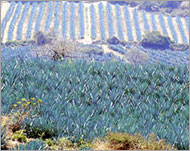World Heritage List gets crowded
For the first time in 34 years, equal numbers of African and European sites have been added to UNESCO’s prestigious World Heritage list.

“During the session, five new sites from Africa and five new sites from Europe were added to the World Heritage List,” said Francesco Bandarin, director of the World Heritage Centre, on Sunday.
“There have long been discussions about the list being unbalanced, but this session has shown in which direction the Committee is moving and shown its commitment to Africa and other emerging regions,” Bandarin said as the World Heritage Committee ended its annual meeting in Vilnius, Lithuania.
Africa now has 70 properties on the list, which with this year’s additions numbers 830 sites. Italy‘s and Spain‘s sites on the list alone outnumber the African listings.
Maori chief elected
Bandarin also announced that Tumu Te Heuheu, the chief of New Zealand’s Maoris, had been elected chairman of UNESCO’s World Heritage Committee, and that the next session of the committee would be held in Te Heuheu’s country in June 2007.
Out of the blue!
|
The new African additions to the list are the fortified historic town of Harrar Jugol in Ethiopia, the Stone Circles of Senegambia in Gambia and Senegal, the Chongoni rock art area in Malawi and the Kondoa rock art sites in Tanzania.
The list also includes the Aapravasi Ghat in Mauritius, where the British government in 1834 launched what it called “the great experiment” in the use of “free labour to replace slaves” -nothing more than indentured labour.
The European sites added are the old town in Regensburg, Germany, Genoa‘s 16th-century Strada Nuova and the palaces of the Rolli in Italy, the Cornwall and West Devon mining landscape in southern England; Poland‘s Anton Berg designed Centennial Hall in Wroclaw, and the Biscay Bridge in Bilbao, Spain.
Sites in Finland and Serbia were extended, and the other sites that made it to the list were in South America, Central America, Asia and the Middle East.
Bandarin said that five sites were taken off UNESCO’s list of endangered sites.
Among the sites taken off the danger list was Cologne‘s cathedral, removed after the authorities in the German city agreed to scale back on development plans that would have affected the Gothic structure’s immediate surroundings.
“This shows that we are heard and listened to,” Bandarin said.
But another site in Germany, the Elbe valley in Dresden, was placed on the danger list because of plans to build a new bridge across the river Elbe.
Removal threat
The picturesque valley was also threatened with removal from the World Heritage List, if the authorities in Dresden do not take a second look at their plans to develop the region.
No site has ever been removed from the World Heritage List, which was established in 1972.
Inclusion on the World Heritage List makes a country eligible for financial assistance from UNESCO and training to help protect and manage sites, or emergency assistance for properties in immediate danger.
The list of World Heritage in Danger is “designed to inform the international community of conditions which threaten the very characteristics for which a property was inscribed on the World Heritage list, and to encourage corrective action,” UNESCO says on its website.
